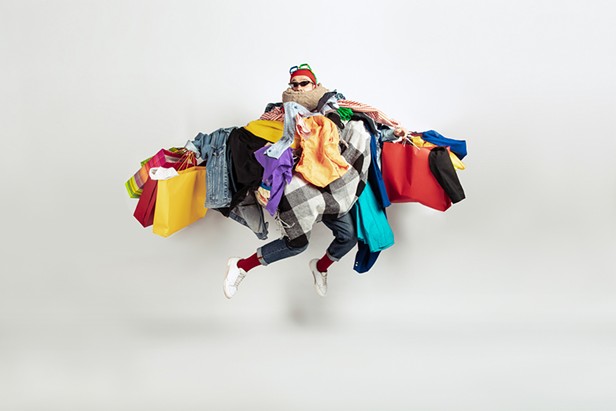Let’s talk about opting out of an economic system that neither our psyches nor our planet can sustain. Welcome to part three of Making Change, a six-week series on the hows and whys of personal, social and political change.
I love to talk about money. (I even wrote a column about it in this paper.) This makes some people uncomfortable. But in American society, almost every conversation is, at heart, about consumerism and how we participate in it. The answers to, “What have you been up to?” can vary from, “Just got back from Baja!” to “Trying to figure out how to get my car fixed.” Inherent in the question, “Want to get dinner?” is, “Can you afford to eat out?” When we talk about what our kids are doing, the choice of activities reflects not only the interests of our little darlings, but also what we can afford to provide them. Talking politics? Your economic concerns influence your opinions as much as — if not more than — your social beliefs. Sharing health tips with friends? You’re also sharing whether you can afford a doctor, prescriptions, supplements and high-end food.
Likewise, every time we buy something new, there’s a story. Someone extracted resources to make a thing. Someone made a thing. Someone profited by selling a thing. Something will have to be done with the thing when it no longer serves its purpose. These alter the appeal and the ethics of the story. And this stuff we buy furthers our own story.
I have a complicated relationship with stuff. On one hand, clutter (in my house, not yours) short-circuits my brain. In the stuff-to-space ratio, I land very hard on the side of more space. Beyond my personal preferences, I spend my days trying to convince people to make good choices for our planet, especially reducing plastic in the environment. I should be the embodiment of the Buy Nothing movement. And yet, the years I spent struggling to pay the bills and stretch my food stamps fostered a scarcity mentality, so when I have money, I want to buy all the nice stuff I couldn’t afford before. A new couch, not a stained hand-me-down. Expensive light bulbs. Gifts for children. A blender that can handle kale. A new surfboard. A robot vacuum. I try to buy — or at least try to try to buy —durable goods made from sustainable materials in the U.S. But I’m too aware of corporate greenwashing to pretend I can shop my way out of climate change or into workers’ rights.
Book rec: How to Buy Essentially Nothing for a Year by Elizabeth Chai
In the introduction to her new book How to Buy Essentially Nothing for a Year, Elizabeth Chai asks, “I claimed to care about sustainability and impacting the world in a positive way … was it all just cheap talk?” This self-examination led her to reduce what she already owned and refrain from shopping for anything other than food, coffee, toilet paper and services that fit her “deep desire to reduce [her] environmental impact and eliminate feeding the monsters of consumerism, fast-fashion and electronic waste.” Not only did Chai want to accumulate fewer material possessions, but she sought a full attitude adjustment on the topics of materialism and excess. To do this, she first identified her values and goals. Next, with those in mind, she made lists spelling out what items were allowed, which were not and which ones would be OK under specific circumstances. Third, she reached out to her community for support in her quest.
She’s now into her fourth year of this revamped way of living and offering a guide to others interested in better aligning their shopping habits with their values. This doesn’t mean living a sad life in an empty apartment. What Chai rejected was unnecessary consumption, instead sourcing items from Buy Nothing groups and the like, while making a move to Portland, furnishing a house and building a tiny home. You might think that is super cool or you might think, “Not for me!” But what definitely is super cool is how Chai crafted her guide for personalization, giving readers the ability to customize their own Year of Buying Essentially Nothing to best fit individual concerns, lifestyle, work and home situations, resources, personality and creative goals.
Reflecting on some of the benefits that inspired her to continue her project-turned-lifestyle, Chai includes the expected “saved a surprising amount of money.” Even more stunning, she developed an immunity to advertising. “Pop-up ads, coupons, billboards and seasonal specials became irrelevant, and therefore practically invisible,” she writes. “Sales and discount codes pitched by social media influencers became little gnats. They’d annoyingly fly in my face, and then I’d mentally shoo them away … I was a casual observer in the zoo of consumption all around me.”
I love how the shift away from participating in a culture destructive to her and the natural environment reached the point where she was completely outside it. Advertisers and social media companies want us to stop, click and buy, and they do everything they can to trick our brains into doing so. Stepping back from their traps is to experience the joy of self-determination. Whether at Costco or the boutique eco-goods shop downtown, impulse-buying and spending on non-essentials define most American consumers. Chai’s book provides tools that enable readers of all economic classes to better live their own values while doing less harm to the planet along the way.
Longtime advice-giver and professional change-maker Jennifer Savage (she/her) is the keynote speaker for this year’s League of Women Voters of Humboldt County 31st annual State of the Community event on April 19.


